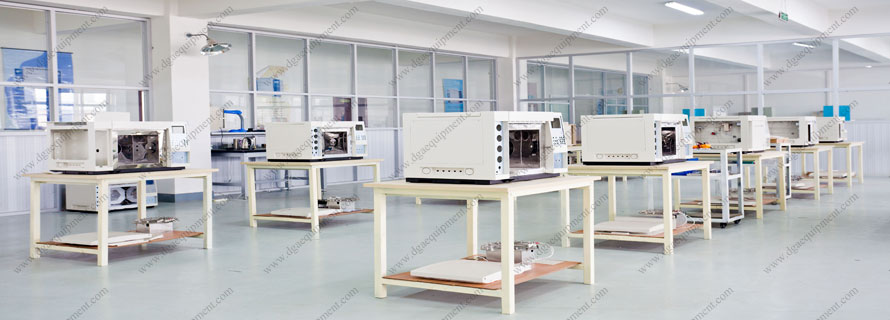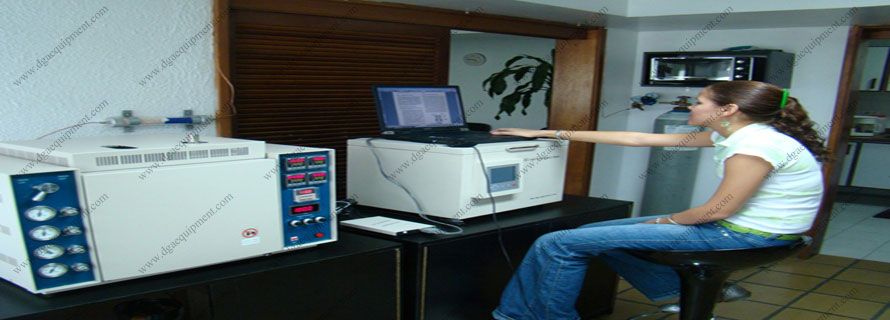ASTM D5846 Standard Test Method for Universal Oxidation Test for Hydraulic and Turbine Oils Using the Universal Oxidation Test Apparatus
10. Procedure
10.1 Adjust the heating block to maintain the oil in the oxidation test cell at 135 +/- 0.5°C.
10.1.1 Other test temperatures can be used but should be specified.
10.2 Weigh 100 +/- 1 g of test fluid into the oxidation test cell.
10.3 Place a cleaned catalyst coil in the oil and fit the basic head and gas delivery tube into the test cell so that the tip of the gas delivery tube rests on the bottom of the test cell inside the catalyst coil, as shown in Fig. 3.
10.4 Insert the test cell into the preheated constant temperature block. Wait 0.5 to 1.0 h for the oil to warm to 135 +/- 0.5°C.
10.5 Connect an air delivery tube from the flow control system to the gas inlet tube and adjust the flowmeter control to deliver dry air at 3 +/- 0.5 L/h. Record this time as the start of the test.
10.6 Recheck the air flow after the test is underway and at least once daily during the test. Adjust to maintain the air flow as needed.
10.7 Withdraw a 2.0 +/- 0.2 g oil sample for determination of acid number at one-day intervals after the start of the test.
10.7.1 Additional samples are taken for acid number determination if desired. More frequent sampling at a time when the acid number is increasing rapidly is helpful to more precisely determine the time to a 0.5 acid number increase.
10.8 Determine the acid number by Test Method D3339 or D5770; alternate test methods such as Test Methods D664 or D974 are used when necessary for oils with short test life. Plot the acid number versus time and terminate the test when an increase in acid number of 0.5 mg KOH/g oil compared to the value for new oil is exceeded. Determine the time to an 0.5 acid number increase from the plot. Alternatively, calculate the time using Eq 1.
10.9 For sludge determination, place a sheet or circle of test paper in a horizontal position on a flat surface in an area shielded from direct drafts. Remove a small sample of oil from the test cell using a micro pipette or glass stirring rod. Allow one drop (approximately 0.05 mL) of liquid to fall onto the test paper, approximately in the center of the sheet.
10.10 Allow the liquid to spread on the paper at room temperature for at least 1 h, but no longer than 3 h (Note 2). Observe the test spot and note any inhomogeneity in the form of a dark ring or spot of insoluble solids. Rate the spot according to the following scale, and terminate the test if the spot rating reaches five.
NOTE 1 - Some oil additives will change color when exposed to air or light on the test paper. Such a change gives the appearance of a sludge spot, but generally such reactions take longer than 3 h to develop.
10.11 Rating Scale for Sludge Spot:

10.12 If a test sample is consumed, through vaporization or sample removal for acid number determination, to the extent that the catalyst coil becomes exposed above the surface of the oil before the condemning limit for acid number or sludge is reached, the test should be terminated.
11. Calculation
11.1 Calculate the oxidation life of the oil, L, as the number of hours to a 0.5 mg KOH/g oil acid number increase as follows:
L = A + ((I + 0.5 - C) x (B - A))/(D - C)
where:
I = the acid number of the oil before the start of the test,
A = the number of test hours when acid number was last measured at less than a 0.5 mg KOH/g increase over I,
B = the number of test hours when acid number was determined to be greater than 0.5 mg KOH/g above I,
C = acid number at A hours, and
D = acid number at B hours.



